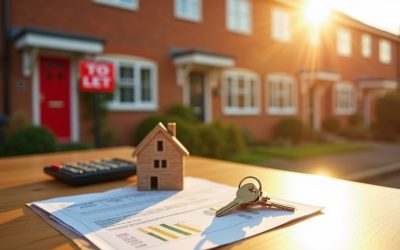When it comes to investing in property and taking the plunge to become a landlord, it’s essential to know that your new venture will be financially beneficial. This is why it’s important to do your research and know just how much money you can expect to make on your UK rental property.
You should make at least 5-8% profit per month on a UK rental property. This number can be increased depending on your rental location, size, and home type.
In the rest of this article, I will explain which types of rental properties yield the most profit, how to calculate your profit from your rental income, the difference between gross and net yield, and rental expenses you should consider before becoming a landlord.
What Type of Rental Properties Will Yield the Most Profit?
Selecting the perfect rental property can be tricky, but if you are looking for ways to stretch your money further and increase your monthly rental profit, here are a few factors that you ought to consider.
Multi-family rental properties will yield the most profit because multi-family properties are able to be split into two separate units. It allows you to double the rent profit while paying a fraction of what it would have cost to purchase two homes.
Purchasing a multi-family home isn’t the only way to increase your monthly rental profit. Several other factors can significantly affect how much income you can make from your rental property.
One of the biggest factors is the location. Certain regions and cities will have higher property values, thus allowing you to charge a bit more for your property. However, those same homes will cost a little more to purchase.
So, let’s take a quick look at some regions in the UK that are the most profitable. These yields are very low. I would suggest that these figures aren’t looking at standard buy to let properties but rather family homes. For a rental property you need to be looking at at least 5%+ yield.
| Region | Average Rent Cost | Average Home Cost | Approximate Yield |
| London | £1,435 | £496,269 | 3.47% |
| South East | £895 | £345,075 | 3.11% |
| East of England | £775 | £306,346 | 3.04% |
| South West | £725 | £279,242 | 3.12% |
| Scotland | £689 | £161,529 | 5.12% |
| Wales | £677 | £179,861 | 4.52% |
| West Midlands | £650 | £215,451 | 3.62% |
| East Midlands | £600 | £213,967 | 3.37% |
Other factors that can significantly affect your rental property yield are:
- Demand: The current demand for rental properties in your location will greatly affect how much you are able to charge for rent and make a profit.
- Updated property: If your property is updated and in good repair, you are more likely to get what you are asking for rent and have more potential tenants interested in the space.
- Rental competition: You should similarly match the price landlords are charging in your area, so it’s essential to do your research before purchasing a rental property.
Ultimately, the best way to get the most out of your money is to purchase a property located somewhere in high demand. However, if you want to take it a step further to maximize your profits, purchasing a multi-family home to rent out would best provide a higher profit yield for less.
How To Calculate Profit From a Rental Property
Now that you understand what to look for when searching for a property with the highest rental potential, it’s time to learn how to calculate your potential rental profit correctly.
Here are the steps for calculating potential profit from your rental property:
- Look at how much you purchased the property for.
- Research how much rent is in your area. You will want to compare the prices of homes similar in size and make to your rental to get the most accurate numbers. Home size, the number of rooms, year built, upgrades, and amenities will affect these numbers.
- Ask yourself if there is a demand for this type of property. Demand for rentals in your area will significantly impact how much you can charge for your property.
- Calculate how much money you will need to cover all of your expenses. Rental expenses include mortgage payments, service charges, property taxes, maintenance costs, and property management fees.
Using these four tools, it’s up to you to set a fair rental price that makes sense for your rental investment.
Let’s say the property is worth £250,000, and the average cost of rent for a property of your size and location is going for about £720. However, if the home you are hoping to rent out has recently been remodelled and comes with a new kitchen and bathroom in a lovely neighbourhood, you will likely be able to charge more.
If there is a high demand for properties like yours, you would be able to charge a little more for monthly rent. Instead of £720, you could charge about £775 or more depending on the current demand for your property type.
Property Investments UK has a great video on how much profit you should make on a rental property in the UK that you should definitely check out for a more detailed guide on rental profits:
The Difference Between Gross Yield and Net Yield
Now let’s talk a bit about the difference between gross yield and net yield when it comes to your rental property.
Gross yield is defined as the overall money made from an investment before one deducts things such as taxes and other expenses. Net yield is the financial return on your investment after the fees and expenses have been deducted.
When purchasing a rental property, it’s imperative to calculate your net yield before jumping into the huge financial commitment of being a landlord.
For further information and additional getting started tips, check out: Property investment for beginners
Rental Expenses To Consider
Before purchasing a rental property and beginning to yield a profit, you should be aware of a few other rental expenses.
The most common rental expense you need to account for:
- Maintenance: Owning a rental property will result in natural wear and tear over time and sometimes more severe damages. As the landlord, it will be your responsibility to repair these damages and maintain a liveable working space.
- Loss of tenants: Should you suddenly lose your tenants, you might find yourself without rent for a month or two while you try to fill the vacancy. This is why it’s essential to have enough savings to cover all of your rental mortgages in an emergency.
- Service charges: Additional expenses can be incurred if you make use of an estate agent or property management company.
- Mortgage payment: If you’re new to property investment you will likely take out a mortgage in order to purchase your first property. Your rental income needs to cover the cost of your monthly mortgage payments as well as all other expenses.
These are just a few expenses you will want to prepare for when purchasing a rental property as an investment. It is vital your know your outgoings before setting your monthly price as the rental income needs to cover all costs before you’ll make any profit. If you treat buying buy to let properties as a business it will pay like a business, if you treat it like a hobby it will pay like a hobby.
Depending on how you wish to market the property, you may also include utility bills. This is more common in shared, buy-to-let property such as student accommodation than in a single family rental. A property that is shared between many people is also known as an HMOs – Houses of Multiple Occupation. This means that at least 3 tenants live there, forming more than 1 household; they might share a toilet, bathroom or kitchen facilities with other tenants.
Remember, you will also need to declare your rental income via a self-assessment tax return. I’d strongly suggest appointing an accountant to help with this as they’ll work out if you’re a basic rate taxpayer or a higher rate taxpayer and will make sure you’re using your allowable expenses correctly.
If you want to learn more about the ins and outs of investing in rental properties for the most yield, I highly recommend The Book on Rental Property Investing by Brandon R Turner (available on Amazon).
Conclusion
How much profit you will yield from your rental income can vary significantly based on location, demand, the type of home you are trying to rent out and the expenses you need to pay.
However, 5-8% is a good baseline for the minimum amount of money you should bring in off your buy-to-let property.
The cheaper you are able to purchase a property, the more profit you will be able to make from the rental income.
Sources
- Douglas Allen: How much can you earn as a property investor?
- Property Investments UK: How Much Profit Should you Make on a Rental Property?
- Kyle Handy: This Is How Much Profit You Should Make On a Rental Property
- Morris Invest: How Much Profit Should You Make On A Rental Property?
- Cubitt and West: What is a good rental yield?
- Stessa: How Much Profit Should You Make on a Rental Property in 2022?
- The Times Money Mentor: Buy-to-let: nine things you need to know
- Reddit: How do people make money from BTL?
- UK Office of National Statistics: Index of Private Housing Rental Prices, UK: January 2022
- HomeLet: HomeLet Rental Index
- Reddit: Owning and renting out properties in the UK.
- SDL Property Auctions: What is a good rental yield in the UK?
- Seven Capital: Best Rental Yields in the UK 2021
- Inventory Base: UK Rental Market Statistics – 2021 Report
- Investopedia: Gross Yield
- Is It Bad To Buy a Flat Instead of Renting? - February 20, 2023
- If You Buy a UK House at Auction, When Do You Pay? - February 15, 2023
- Why Are Houses in the UK So Overpriced? - February 7, 2023


